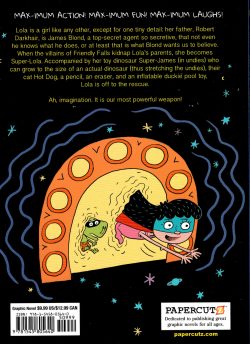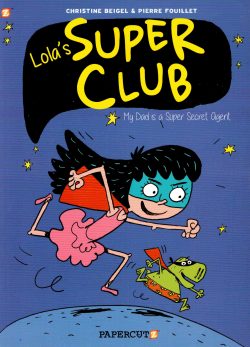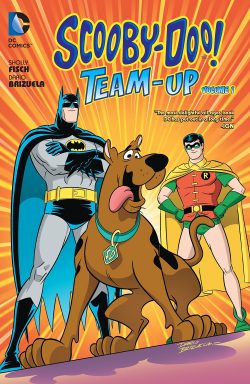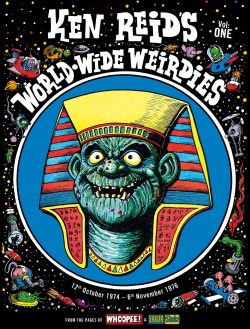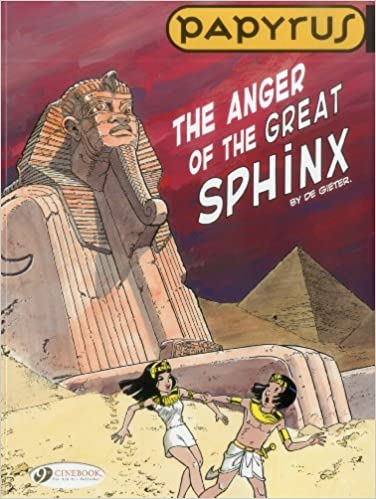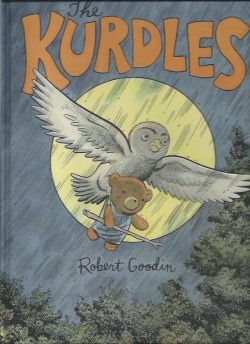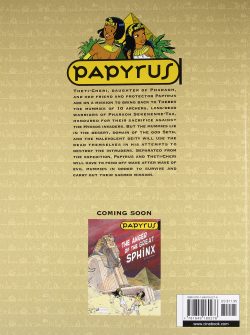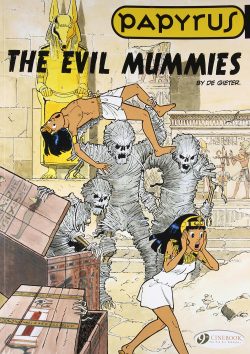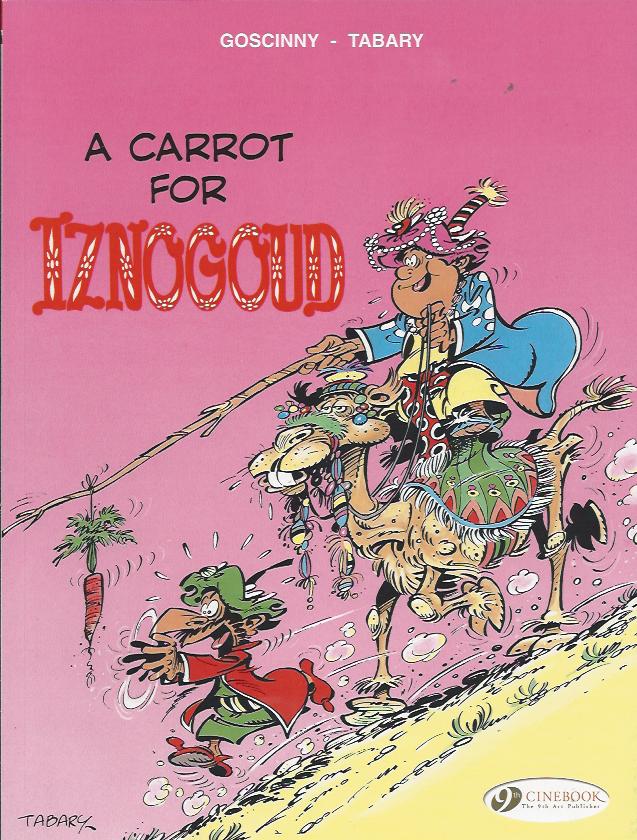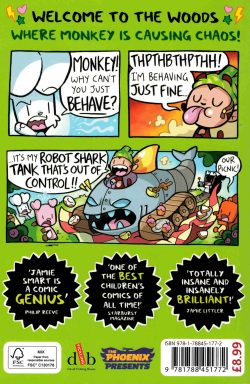
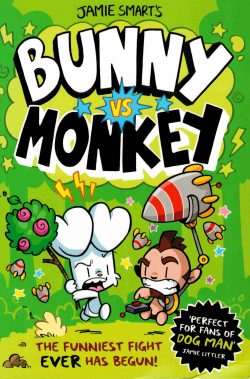
By Jaimie Smart, with Laura Bentley & Sammy Borras (David Fickling Books)
ISBN: 978-1-78845-177-2 (PB)
Concocted with gleefully gentle mania by cartoonist, comics artist and novelist Jamie Smart (Fish Head Steve!; Looshkin; Flember), Bunny vs. Monkey has been a fixture of British periodical sensation The Phoenix from the very first issue: a madcap duel of animal arch rivals set amidst the idyllic arcadia of a more-or-less ordinary English Wood. Those trend-setting, mind-bending antics were rapidly retooled as graphic albums and are now being re-released in remastered, double-length digest editions. In case you’re wondering, the fabulous fun found here originally inhabited volumes 1 & 2, entitled Let the Mayhem Begin and Journey to the Centre of the Eurg-th…
With precious little unnecessary build-up, the manic happy returns commence with a ‘Prologue!’ introducing placid, wise, helpful Bunny and not-so-smart pals Pig and Weenie Squirrel. The foolish innocents and lifelong residents of idyllic Crinkle Woods have found a hibernating bear which Bunny really wants them to stop trying to wake up…
Meanwhile, over the hill and not so far away, a bunch of boffins are attempting to launch a really annoying monkey into space…
This prompts a barrage of seasonal silliness in ‘Bunny vs. Monkey’, as the proposed launch goes hideously awry and the loud, stroppy, obnoxious simian lands in the snow-covered glade and instantly declares himself king of this strange alien world…
Monkey loves noise, strife, chaos and trouble and incessantly needs to raise a rumpus – everything genteel, contemplative Bunny abhors – so when our apish astronaut introduces techno music in ‘Keep it Down!’, the lines of battle are irrevocably drawn…
Thing escalate in ‘When Monkey Met Skunky’. This latter is a brilliant inventor with a bombastic line in animal-inspired terror weapons such as the Cluck Cluck Zeppelin used to bomb the woods with 10-year-old rotten eggs or the giant metal robot hands which give the destructive Monkey ‘Fists of Fury’…
Winter draws on with ‘Soggy ‘n’ Froggy’ wherein a monstrous Frog-O-Saurus becomes the wicked duo’s latest Weapon of Meadow Destruction, after which poor Pig is transformed into cyborg sensation Pig-O-Tron 5000 in ‘Robo-Chop’ as a simple change of pace sees Weenie and Pig put on a circus show to counter all the nasty animosity before getting painfully caught ‘Clowning Around’…
Up until now Monkey has been risking his own pelt road-testing all Skunky’s inventions, but when a bewildered former stuntman turns up, the sneaky simian is happy to leave all the dangerous stuff to ‘Action Beaver’…
March leads to a profusion of beautiful buds and blossoms which delight the soul of nature-loving Bunny.
Tragically they utterly disgust Monkey, who tries to eradicate all that flora in ‘Down with Spring!’ until he comes a-cropper thanks to a sack of spiky “Hodgehegsâ€, whilst in ‘Bonjour, Le Fox’, the spacy invader finally goes too far, forcing Bunny to align with a rather radical environmentalist possessed of a big, bushy tail and an outrrrrrageous French accent…
Some of Bunny’s friends are their own worst enemies. ‘Race to the Moon!’ sees Weenie and Pig build their own spaceship – out of natural materials like moss and mushrooms – only to have Monkey disastrously commandeer it, after which Skunky builds a terrifying cyber crocodile dubbed ‘Metal Steve!’ which ignores its perfidious programming to spend the day swimming. Such shameful failures thus compel Monkey to steal a steamroller to personally get rid of all that hateful, ugly cherry blossom infesting the trees in ‘Rollin’ Rollin’ Rollin’!’…
The war against nature intensifies as ‘Eat Your Greens!’ sees Skunky’s Caterpillar-Zilla devouring forest foliage until an authentic creepy-crawly steps in, whilst ‘The Whuppabaloo!’ shows the niffy tinkerer’s softer side as he drags Monkey on a wilderness trek to track down the most amazing thing in nature…
‘Hide and Squark!’ depicts the rabbit’s fightback, thanks to the double-dealing help of a certain giant parrot, after which a momentary détente for a spot of angling inevitably turns into another heated duel in ‘Fish Off!’ after which a brief falling out of the axis of evil in May ends as ‘Invisi-Monkey’ sees the strident simian squabbling with Skunky to possess a sneaky stealth suit. The status quo sees the villains reuniting to spoil a joyous game of Cake-Ball with their monolithic, monstrous ‘Mole-a-Rolla!’…
‘Black Gold’ finds Monkey attempting to turn the Wood into an oil field, before spoiling Bunny’s dream of a ‘Quiet Day!’with a giant Robot Cockroach…
Blazing June opens with ‘Bring Him Back!’ as Action Beaver attempts to retrieve watery wanderer Metal Steve whilst simple souls Weenie and Pig accidentally kick off an invention Armageddon which only intensifies after that long-slumbering ursine finally wakes up in ‘Who’s Afraid of the Big Bad Bear?’
‘The Bat!’ apparently introduces a nasty new faction to the ongoing conflict (but all is not as it seems!), and there’s no confusing the stakes when Bunny agrees to a winner-take-all fight in ‘Wrestlepocalypse!’ and Monkey learns that cheats never prosper…
Just when things seem likely to settle down, fresh chaos ensues when a violent piratical rabbit – with an eye-patch – storms in to cause stir up trouble in ‘Bunny B!’…
With battle reports spanning July to December, hostilities reach new heights and depths as Monkey and Skunky fail to make proper use of ‘The Wish Cannon!’ This reality-warping gun could change the world, but also makes really good cakes…
A far better terror-tool is colossally ravening robot ‘Octo-blivion!’, which ruins Bunny’s boating afternoon, but sadly the tentacled doom-toy becomes an irresistible object of amorous intent for irrepressible cyber crocodile Metal Steve before it can complete its nefarious machinations…
A hot day inspires Monkey to demand his bonkers boffin whip up some volcanoes, but their ‘Journey to the Centre of the Eurg-th!’ only unearths chilly regions and crazily cool creatures before the scene shifts to those not-so-smart but astonishingly innocent bystanders Pig and Weenie.
An afternoon playing with crayons results in a lovely drawing of a crown, and soon everyone is bowing down and obeying ‘King Pig’, after which surly radical environmentalist ‘Fantastique Le Fox!’ finds time to share his incredible origin stories with the dumbfounded woodland denizens. Yes, that’s right: stories, plural…
Hyperkinetic carnage is the order of the day when a cute little dickens turns up inside spiffy running-toy ‘Hamsterball 3000!’, providing Skunky with the perfect power source for his latest devastating mechanical marauder: the horrendous Hamster Mobile…
Puns, peril and a stinging hidden moral then inform proceedings when all the animals celebrate ‘Bee-Day!’ whilst a certain happily brain-battered, bewildered former stuntman turns into a tormented super-genius when he accidentally falls under the influence of Skunky’s Smarty Helmet in ‘Action Beever2‘.
Happily for everyone, before it wears off the increased cognition – in conjunction with a handy lemon puff – demolishes an unleashed Doomsday Device which might just have ended everything…
From September onwards the stories drop to four pages a pop as ‘Gone with the Wind!’ finds Pig and Weenie making trouble with their windsurfing cart after which ‘I, Robot Crocodile!’ sees Metal Steve on a destructive rampage until Bunny and Monkey team up to show the steel berserker the simple joys of dance…
‘There’s a Moose Loose!’ depicts Skunky back on bad form and trying to fool his enemies with a vast Trojan Elk before Monkey spoils everyone’s September by going big after being introduced to a sweet childhood game in ‘Conkers Bonkers!’ after which – with the Beaver temporarily bedridden – the perfidious pair of animal evildoers employ the rather dim ‘Action Pig!’ to test pilot their devilish Dragonfly 5000. Such a bad idea…
Tidy-minded Bunny has no hope of sweeping up all autumn’s golden detritus in ‘Leaf it Alone!’ once friends and enemies start helping out, and an extended sub-plot opens in ‘Duck Race!’ as impetuous Monkey pries into Skunky’s most deadly and diabolical secrets all stashed behind a locked door. In a frantic attempt to deflect attention, the smelly scientist then unleashes the colossal Lord Quack-Quack!
The saga sequels in a surprisingly downbeat follow-up as Bunny, Pig and Weenie dare the fiend’s lair to check out ‘Door B’ before scheduled insanity resumes as ‘Hypno-Monkey!’ finds the hirsute horror misusing a memory ray and briefly assuming godlike power…
Who doesn’t like igniting marshmallows and telling scary stories around a campfire? Not Bunny, Pig and Weenie after hearing the tale of ‘Monster Pants!’ leading to the local idiots deciding to join Monkey’s gang in ‘Bad Influence!’
The monkey is no one idea of a role model – except perhaps for painful ineptitude – as seen in ‘Lost in the Snow!’, but the winter fun expands to encompass everyone when Skunky’s ‘Chemical X!’ unleashes a chilled tidal wave of blancmange leading to seasonal silliness as ‘The Small Matter of the End of the World!’ exposes time-travelling madness as the true story of the demise of the Doomsday Device is finally exposed in an extra-length yarn…
Everything changes when ‘Merry Christmas Mr. Monkey!’ sees peace and goodwill grip the woods – or perhaps it’s just that the simian seditionist has gone missing? When the innocent inhabitants go looking for Monkey, they find him far beyond the forest associating with strange two-legged beings, singing carols and swiping mince pies, but nobody realises just how dangerous ‘Hyooomanz!’ can be as the year ends with plans found proclaiming the demolition of Crinkle Wood and the coming of a new motorway…
To Be Continued…
Adding lustre and fun, this superb treat includes detailed instructions on ‘How to Draw Bunny’ and ‘How to Draw Monkey’, so, as well as beguiling your littl’uns with stories, you can use this book to teach them a trade…
Endlessly inventive, sublimely funny and outrageously addictive, Bunny vs. Monkey is the kind of comic parents beg kids to read to them. Why isn’t that you, yet?
Text and illustrations © Jamie Smart 2020. All rights reserved.



